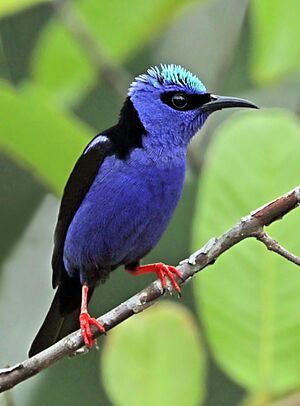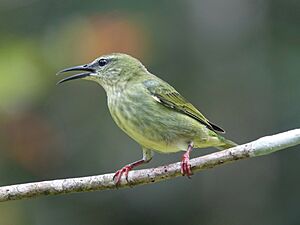Red-legged honeycreeper facts for kids
Quick facts for kids Red-legged honeycreeper |
|
|---|---|
 |
|
| Adult male, Panama | |
 |
|
| Female | |
| Conservation status | |
| Scientific classification | |
| Genus: |
Cyanerpes
|
| Species: |
cyaneus
|
 |
|
| Synonyms | |
|
Certhia cyanea Linnaeus, 1766 |
|
The red-legged honeycreeper (Cyanerpes cyaneus) is a small, colorful songbird. It is part of the tanager family. You can find this bird in warm, tropical parts of the New World. This includes areas from southern Mexico all the way down to Peru, Bolivia, and central Brazil. It also lives on Trinidad and Tobago and Cuba. Sometimes, it is even seen in southern Texas.
Contents
About the Red-legged Honeycreeper
Scientists use a system called taxonomy to name and group all living things. The red-legged honeycreeper was first officially described in 1766. This was done by a Swedish naturalist named Carl Linnaeus. He gave it the scientific name Certhia cyanea. Later, it was placed in the group, or genus, called Cyanerpes. The word cyaneus is Latin and means "dark-blue."
There are eleven different types, or subspecies, of the red-legged honeycreeper. They are mostly found in different areas:
- C. c. carneipes – from eastern Mexico to Panama
- C. c. pacificus – in western Colombia and western Ecuador
- C. c. gigas – on Gorgona Island, off western Colombia
- C. c. gemmeus – in the very north of Colombia
- C. c. eximius – from northern Colombia to northern Venezuela
- C. c. tobagensis – on Tobago
- C. c. cyaneus – on Trinidad, eastern Venezuela, the Guianas, and northern Brazil
- C. c. dispar – from southeastern Colombia and southwestern Venezuela to northeastern Peru
- C. c. violaceus – from southeastern Peru and western Brazil to central Bolivia
- C. c. brevipes – in central Brazil
- C. c. holti – in eastern Brazil
What Does It Look Like?
The red-legged honeycreeper is about 12.2 cm (4.8 in) long. It weighs around 14 g (0.49 oz). It has a medium-long, black beak that curves slightly downwards.
The male bird is mostly a beautiful violet-blue color. Its wings, tail, and back are black. Its legs are bright red. The top of its head is turquoise. When it flies, you can see its bright lemon-yellow underwings. After the time for raising young, the male bird changes its feathers. It becomes mostly greenish with black wings. This is called its eclipse plumage.
Female birds and young birds look different. They are mostly green. Their undersides are lighter and have faint streaks. The female's legs are reddish-brown. Young birds have brown legs.
The call of the red-legged honeycreeper is a thin, high-pitched tsip.
Where Do They Live and What Do They Eat?
This bird likes to live at the edge of forests. It also lives in open woodlands. You can often find it in cocoa and citrus farms. Red-legged honeycreepers are often seen in small groups.
They eat insects, seeds, fruit, and nectar. Nectar is the sweet liquid found in flowers.
Life Cycle and Reproduction
In Costa Rica, red-legged honeycreepers usually have their young between April and June. The female bird builds the nest all by herself. She places it in a bush or tree, several meters above the ground. The nest is shaped like a cup. It is made of strong fibers and held to the branches with cobwebs.
The female lays two eggs. She lays them early in the morning on two days in a row. The eggs are about 13.4 mm × 19.1 mm (0.53 in × 0.75 in) in size. They are white with brown speckles that form a ring around the wider end. The female sits on the eggs for 12 or 13 days to keep them warm. This is called incubating.
When the baby birds first hatch, their eyes are closed. They are covered with soft, gray fuzz. The female keeps them warm. Both parents help feed them. The young birds are ready to fly after about 14 days.
The red-legged honeycreeper is a common and widespread bird. It is not considered a threatened species by the IUCN. This means it is not in danger of disappearing.
Gallery




